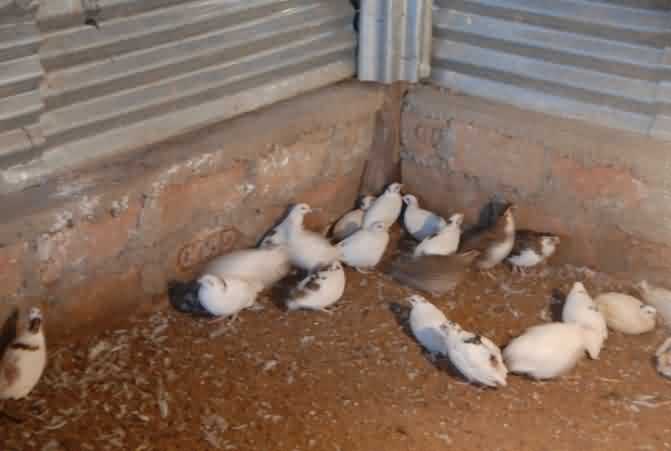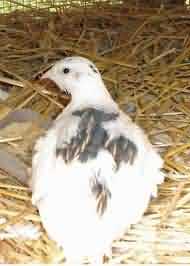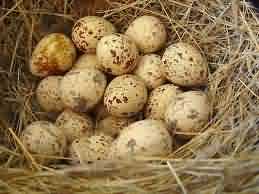घर के पिछवाड़े मे बटेर पालन - ग्रामीण किसानों के लिए एक नया उद्यम
 The quail (Coturnix coturnis japonica), in Hindi called ‘Bater’ is raised for egg and meat production. It is one of the best source of non-vegetarian diet and a good converter of agri-byproducts or cereals to animal protein.
The quail (Coturnix coturnis japonica), in Hindi called ‘Bater’ is raised for egg and meat production. It is one of the best source of non-vegetarian diet and a good converter of agri-byproducts or cereals to animal protein.
The quality of ‘Bater’ meat is very high due to low calorific values, nutrient contents is more, very tender, juicy and delicious meat. The dry matter content in quail meat is high.
To boost up the family income particularly for poor farmers who do not have any other source for high investment for diversified farming can easily opt for low cost quail farming.
Initial investment is very less in comparison to other livestock farming and suitable for landless and marginal farmers. It is ideal for backyard farming also.
|
Source: www.grit.com |
Quail is a small bird and weigh about 200 to 250 gm at mature age. Generally males are lighter than female.
Identification of male and female can be done at 3 to weeks of age. Males are cinnamon colour at upper portion of breast and lower portion is having light brown in shade.
Female colour varies from brown with black markings in throat, face and upper portion of breast but, tan colour in lower portion.
In male there is hypertrophied gland in cloeca. The newly hatched chicks are brown in colour with yellow stripes. At the age of 6 weeks female start laying and at 50 days age starts full production.
On an average a quail lays 280 eggs/ year. The egg weight is 10 to 12 gm and colour of egg shall is white to brown with dark coloured mottling and often covered with a light blue chalky material.
Generally quail lay eggs at evening hours between 3 to 6 pm and in some cases at night. Throughout the year quail lay eggs.
|
Source: www.ennyrehoboth.com |
The egg of quail is handled very carefully because of very thin egg shell. Eggs are collected 2 to 3 times a day to avoid egg loss. The weight of hatched chick is 0.8 gm and unsuitable for transportation. Hence, they are reared at production site up to 2 weeks and thereafter shifted to farmers’ door. At the age of 5 weeks they weigh about 180 to 200 gm.
Why to start quail farming?
- Quail is very prolific and have short generation interval.
- Have twin capacity for egg and meat production.
- Quail meat with low calorific value and high protein content it is recommended for children, old family member and pregnant women.
- It is one of the cheapest sources of animal protein and can be adopted as backyard farming for egg and meat production.
- Due to hardiness and adoptable capacity the quail can thrive in adverse conditions also when other livestock easily collapse.
- For rural poultry and backyard farming quail farming can be started with minimum investment.
- Space requirement and demand for feed supply is very less in comparison to other livestock like poultry.
- Laying capacity is more and meat quality is better.
- Resistant to most of the poultry diseases and require no vaccination.
- High economic return and can be utilized for egg and meat purposes as and when required.
Housing of quail
The optimum room temperature and relative humidity at quail house is 15 to 20⁰ C and 40 to 70 %, respectively. The birds can be reared in litter system or in cage. If litter system is practiced, locally available bedding material can be used.
The room should be well ventilated, insulated and free from dust. Dry litter approximately 10 cm thick may be provided in deep litter system. The bird should also be protected from predators like dog, cat, rodents, hunting birds etc.
For a quail up to 4 weeks of age 145 to 150 sq cm is sufficient, but up to 5 weeks and above 250 sq cm is required. In general in deep litter system 70 birds can be housed in one sq mt area and in cage system 80 birds per sq mt area. Sometimes the quail hide their eggs inside the litter. Hence, the cage housing is preferred in quail farming to reduce the egg loss. The size of the cage may be 13 x 20 cm for two birds.
To get the optimum production hygiene and sanitation is must for quail farming. The quails are territorial in nature and they defend their home from other new entrants. If two groups of birds are introduced in same cage or in room, may be placed both of them in new cage to avoid infighting.
Quail can be raised in multitier system. The length of the tier is 120 cm, height 25 cm and width 60 cm. Twenty to 40 birds can be housed in one tier. The space requirement for feed and water is 2.0 cm and 1.0 cm up to 3 weeks of age and 3.0 cm and 1.5 cm, respectively up to 3 to 6 weeks and above.
To avoid feed loss the feed trough should be filled up to three forth and there should be provision for clean drinking water throughout the day.
Quail house should have facility for 14 to 18 light hours for optimum feed intake and egg production. In winter months or in rainy days extra light may be provided in the quail house. If quails are raised commercially for meat purposes 24 hours light may be provided for early growth and higher market value.
Breeding of quail
The ideal age of breeder is 10 to 30 weeks. During 2 to 8 months of age group fertility remains maximum in quails and after that gradually declines. The male female ratio should be 1:3. Before incubation eggs may be stored at 13⁰C with 70 to 75% humidity after fumigation. Eggs may be stored up to 7 days. Beyond 7 days hatchability will be reduced. Eggs are stored in a plastic bag to reduce dehydration.
Selection of hatching eggs
Clean, defectless and sound eggs may be selected for incubation. A medium size egg selected for hatching should have 10 to 11 gm weight.
The eggs are disinfected before incubation by fumigation with formaldehyde gas for 15 to 20 minutes which contains Potassium permanganate and 40% formalin. After fumigation eggs are arranged in setting tray by keeping broad end up for incubation.
Incubation of eggs
Eggs are incubated for 17 to 18 days. Up to 14 days from day one the temperature of incubator should be 37.5 ± 0.3⁰C with 60% humidity. After 14th day till 17th day relative humidity should be maintained up to 70% in hatcher.
During incubation period eggs are turned uniformly 8 times/day or every 2 to 4 hours to prevent sticking of embryos to egg shell. On 17th or 18th day chicks hatch out from egg.
Care for newborn chicks
Care for chicks in 1st week is very important because the chicks are very delicate and weigh only 7 to 8 gm. Chick mortality may occur if proper care and management is not provided to newborn chick. There should be provision for 24hrs light in brooder house. If there is light failure chick may huddle together and collapse.
Sometimes chicks drown in waterer. To avoid chick drowning pebbles may be given inside the waterer and also corrugated paper may be spread over the litter or wire mesh to avoid sprawling of legs during 1st week after hatching. It is advisable to put about 150 or less chicks in a single brooder for prevention of stampeding.
Different types of brooder can be used for quail brooding, namely floor brooding, battery brooding, gas brooding etc. Heater or electric bulb may be used for provision of heat generation in brooder house.
Battery brooding is advantageous than floor brooding. The brooder house temperature should be initially 37⁰C and gradually temperature may be decline at the rate of 3⁰C for every 4 days.
Generally brooding is done for 3 weeks but provision for extra light may be continued for 5 weeks for early maturity and growth.
Feeding management of quail
Feed alone consider 70% feed cost of quail farming. Hence, the feeding should be balanced, economical and with preferably with locally available material may be used for feed formulation. In backyard quail farming agri-byproducts and household leftover food grains may be utilized for maximum profit.
In backyard farming it is always advisable with minimum input maximum gain. However, for commercial or medium to large scale quailfarming balanced ration with 2700 to 2800 ME Kcal/kg of feed, 22 to 27% protein and adequate calcium (3%) particularly during laying period and phosphorus (0.8%) along with vitamins and minerals may be provided in quail ration.
During early stage i.e. in starter and grower period the demand for essential amino acid and protein is more and for optimum growth molasses at the rate of 6 to 8% may also be provide at least for 3 to 4 days. An ideal quail ration may be prepared with following ingredients.
| Ingredients | Starter ration | Grower ration | Layer ration |
| Rice polish | 14 | 9 | 10 |
| Maize | 43 | 35 | 40 |
| Groundnut cake | 16 | 30 | 25 |
| Sunflower Cake | 14 | 12 | 10 |
| Fish meal | 10 | 12 | 10 |
| Bone Meal | 1.4 | 0.7 | 0.2 |
| Lime Stone | 1.0 | 0.5 | 0.5 |
| Salt | 0.3 | 0.5 | 0.5 |
| Vitamins and Minerals | 0.3 | 0.3 | 0.3 |
According to age group feed consumption varies. During 1st week it is 5 gm, 2nd week 10 gm, 3rd week 15 gm, 4th week 19 gm, 5th week 22 gm and 6th week and above 25 gm. An adult quail daily consume 20 to 25 gm feed.
Health care management for quail
Unlike other poultry species no special care or attention is required for quail except environmental stress. During first two weeks the chicks remain very fragile and environmental changes particularly in summer and winter months required special care like protection from summer or winter stress, hot or cold wind, heat stroke etc.
Quail are resistant to some of the poultry diseases like Ranikhet disease, Fowl pox etc. Quail do not require vaccination, deworming however, regular cleaning and hygiene is must in quail farm.
To prevent cannibalism debeaking is recommended in commercial quail farming. Debeaking can be done with simple nail cutter. But, over cutting of beak may lead to lower fertility in quail due to mating problem in males.
Authors:
¹ Asit Chakrabarti, ² Pankaj Kumar, ³Shanker Dayal, ⁴ J J Gupta, ⁵ Amitava Dey, ⁶ Rajni Kumari and ⁷S K Barari
¹ Senior Scientist (LPM), ² Scientist (Vet. Med.), ³Senior Scientist (AGB), ⁴ Principal Scientist (AN), ⁵ Principal Scientist (AN) & Head, ⁶ Scientist (Anim. Biotech.) and ⁷ Chief Technical Officer
Division of Livestock & Fishery Management, ICAR Research Complex for Eastern Region
ICAR Parisar, P.O. Bihar Veterinary College, Patna- 800014, Bihar
¹ E-mail:


